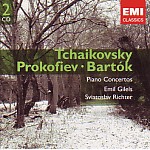Nearly all of the studio and live accounts of Tchaikovsky’s First Concerto with Emil Gilels stand out for the pianist’s powerful projection and astonishingly honest fingerwork. Whatever the 1972 EMI studio version lacks in sheer magnitude is compensated by steadier, more cohesive tempo relationships and fastidious orchestral execution from top to bottom. That said, I respect the performance more than I truly like it. Lyrical sections have a rounded-off, slightly prosaic quality (the slow movement is a bit earthbound and without the balletic charm you hear from Cliburn/Kondrashin, Schiff/Solti, or Argerich/Abbado) while big chords and tumultuous octaves grow harsh and colorless with increased volume.
Furthermore, there are instances that confirm my general impression of Gilels as an artist who often put pianistic efficiency ahead of musical considerations. One telltale example in the first-movement main theme concerns his habit of playing the rhythmic figure of two triplets followed by a rest with the accent on the second note rather than the downbeat, even though the orchestra does the opposite. In other words, Gilels plays “ba-DUH ba-DUH ba-DUH” when it should be “BA-duh BA-duh BA-duh”.
For some reason, Gilels responds more to the Second Concerto’s potential for tone color and infuses his surface perfection with more sensitivity and nuance (the finale’s main theme, for instance). This remains one of the catalog’s strongest studio versions (along with Graffman and Pletnev), so long as you know that Gilels follows the once-common Siloti revisions and cuts throughout. As for the single-movement version of the Third Concerto, Gilels and Maazel still lead the pack for attention to detail and regimented precision, but for poetic sweep and flexible imagination, I prefer Graffman/Ormandy, or, for the three-movement version reconstructed by Tanyev, the superb Scherbakov/Yablonsky edition.
Sviatoslav Richter’s Prokofiev Fifth Concerto with Maazel and the London Symphony is hampered by diffuse sonics and skewed balances that make it difficult to fully absorb the music’s quick-witted ensemble interplay and chamber-like scoring. Richter’s incisive mastery and immersion in the idiom leaves no room for doubt, yet I prefer the generally brighter tempos and rhythmic spring of Richter’s earlier, better-recorded DG version.
Richter is on top form in Bartók’s Second Concerto. When this 1969 recording first appeared, Richter’s sensitivity to the music’s lyrical content and speech-oriented inner rhythms stood apart from the percussive glare and notey phrasing characterizing the contemporaneous Entremont and Weissenberg traversals. By contrast, the Orchestre de Paris’ fuzzy brass and confusingly spot-lit instrumental balances remain problematic. I’m sure Gilels and Richter fans who missed earlier CD incarnations of these uneven performances will want to check them out at budget price.
































